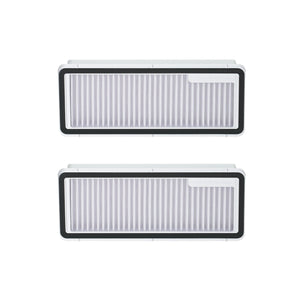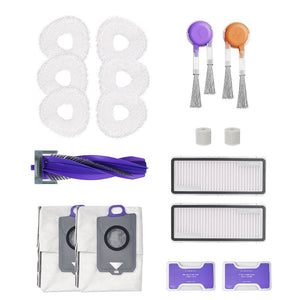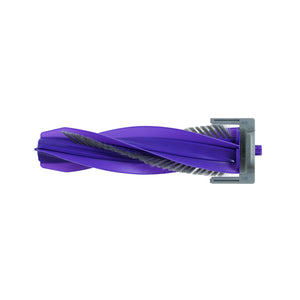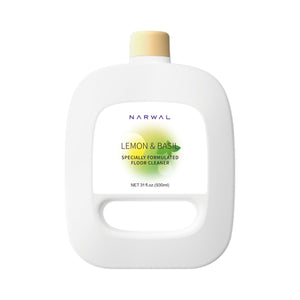Have you noticed your vacuum brush not spinning — whether it’s a robot vacuum brush not spinning, or your upright vacuum roller stuck on carpet? You’re not alone. In this guide, we’ll show you why it happens and how to fix it fast, with step-by-step solutions for Roomba, Shark, Dyson, Narwal, and Deebot models.
From tangled hair and clogged hoses to worn-out belts, here’s everything you need to know to get your vacuum brush spinning smoothly again.
Quick Checklist for Brush Roll Not Spinning
Before diving into detailed troubleshooting, it’s helpful to perform a quick pre-inspection. Many users search “why did my vacuum stop spinning” or “vacuum roller not spinning”, and often the fix is simple. Start by checking the power switch, brush roll control, and making sure the brush roll height is set correctly—especially if your vacuum brush is not spinning on carpet, which may indicate a pile height misadjustment.
Check Power Switch
Ensure the vacuum’s main power switch is turned on. It’s easy to overlook, but a simple power switch error could be the reason why your vacuum brush isn’t spinning.
Brush Roll Control Switch
- Many modern vacuums, especially those with multi-surface capabilities, have a separate switch specifically for controlling the brush roll.
- Certain vacuums, when set to hard floor mode, may automatically turn off the brush roll to prevent damaging sensitive surfaces.
Brush Roll Height Setting
- The pile height setting of the brush roll can also affect its ability to spin. Different carpets require different brush heights. Adjust the height setting to match the surface you’re cleaning for optimal brush roll performance.
- For high-pile carpets, a brush set too low may not be able to rotate freely, while for low-pile or hard surfaces, the brush might be too high to make effective contact.
Common Causes for a Vacuum Brush Not Spinning
If you’ve gone through the pre-inspection checklist and your vacuum brush is still not spinning, the issue may be due to a few common causes. Many users search for “ robot vacuum brush not spinning” or “Roomba brush not spinning”, and the most frequent culprits include tangled hair and debris, worn-out belts, motor problems, or a full dustbin. Inspecting these components is the next step toward getting your vacuum cleaner roller spinning again.
Brush Roll Tangled with Debris
Hair, strings, and other debris can wrap tightly around the vacuum brush, jamming it and preventing it from spinning. This buildup restricts the movement of the brush roll and can damage the motor or belt if not addressed.
For users tired of constant tangles, the Narwal Flow solves this pain point with its DualFlow Tangle-Free System. Certified by SGS, it achieves a 0% hair tangling rate on both human and pet hair, keeping the brush roll spinning freely without frequent manual cleaning.
[cta:flow-robot-vacuum-and-mop]
Clogged Vacuum Hose
Larger debris like dirt clumps, hairballs, or small objects can get stuck inside the vacuum hose, reducing suction power. When suction is weak, it can affect the brush roll’s ability to spin, especially in vacuums that rely on airflow for brush movement.
Affected Vacuum Types:
- Canister Vacuum
- Upright Vacuum
- Central Vacuum
Full Dustbin or Bag
When the dustbin or bag is too full, overflowing debris clogs the system, leading to poor suction and preventing the brush from rotating properly.
Worn-Out or Broken Belt
In belt-driven vacuums, the belt connects the motor to the brush roll. Over time, belts can stretch, slip off, or break, leaving the brush roll immobile.
A loose belt may cause partial spinning or intermittent issues, while a broken one will stop the brush completely.
Affected Vacuum Types: Models with belt-driven brush roll
- Upright Vacuum
- Canister Vacuum
- Stick Vacuum
Motor or Power Issues
In vacuums with a motorized brush roll, electrical issues such as motor failure, wiring problems, or power loss can prevent the brush from spinning. It’s due to power issues or battery problems.
Unlike traditional vacuums that lose efficiency on carpets, the Narwal Flow uses 22,000Pa Hyper Suction and CarpetFocus Technology to boost pickup power by up to 2x over the industry average, ensuring the brush continues spinning even on thick carpet fibers.
Affected Vacuum Types: Models with brush motor
- Stick Vacuum
- Robotic Vacuum
- Canister Vacuum
Incorrect Assembly or Loose Parts
After maintenance, cleaning, or replacing parts in the vacuum, improper reassembly or loose components can prevent the brush roll from functioning as intended.
Hard Floor Mode
Some vacuums have a hard floor mode that disables the brush roll to protect delicate surfaces like hardwood floors. When this mode is activated, the brush won’t spin even if there are no obstacles. This feature is designed to prevent scratches and damage to sensitive flooring but can be confusing if users aren’t aware of the setting.
Inappropriate Pile Height
If the brush is set at an incorrect pile height (too low for high-pile carpets or too high for low-pile carpets), it may not rotate properly. The brush roll needs to make proper contact with the carpet fibers to spin effectively. Incorrect height settings can cause the brush to either dig too deeply into the carpet or float above it, preventing rotation.
Why Your Vacuum Brush Stops Spinning on Carpet
If your vacuum brush isn’t spinning on carpet, don’t panic — it’s usually not a broken motor. In most cases, the problem comes from an incorrect brush roll height or reduced suction power rather than a mechanical failure.
When the brush is set too low, it digs too deeply into carpet fibers and stalls; when it’s set too high, the roller can’t make enough contact to spin effectively. To fix it, adjust the brush roll height according to your carpet type and check the filters and hose for clogs to restore suction.
This issue is especially common in upright and robot vacuums — including Shark, Dyson, Roomba, and even Narwal models — when switching from hard floors to carpet. With the right height and clean airflow, your vacuum brush should spin smoothly again.
Robot Vacuum Brush Not Spinning? Brand-Specific Fixes
If your robot or cordless vacuum brush is not spinning, don’t worry — it’s one of the most common issues across popular brands like Roomba, Deebot, Dyson, Roborock, and Narwal. Most of the time, the cause is hair tangles, clogged side brushes, or a stalled brush motor, not a serious malfunction.
Here’s how to fix it for each brand:
Roomba
Remove the yellow brush module and clean both ends of the main brush. Use the cleaning tool included with your Roomba to cut away tangled hair or debris. If the brush still doesn’t spin, open the brush motor module, clear any dust or fibers, and make sure the connectors are firmly in place. Regularly removing and cleaning both the main and side brushes helps prevent motor overload errors.
Deebot
Detach both side brushes and the main roller. Inspect the hubs for wrapped hair or lint and clear them completely. If your Deebot displays a “main brush stuck” or “side brush error” message, reset the robot after cleaning. Keep the roller and side brushes free from buildup to maintain smooth rotation.
Dyson
If your Dyson brush bar or roller isn’t spinning, first unplug or power off the vacuum. Flip the cleaner head and remove any visible hair or threads wrapped around the roller. Check the brush bar reset button (found near the head on many models such as the Dyson V8 or V10). If it has tripped, press it to reset the motor. Make sure the cleaner head is securely connected and the vacuum isn’t set to hard floor mode, which disables the brush roll automatically. If the issue persists, the motorhead or belt may require replacement — contact Dyson support for assistance.
Narwal
Remove the dual roller brushes and clean them using Narwal Flow’s self-cleaning base or rinse gently under warm water. The tangle-free brush design helps prevent future jams and minimizes maintenance effort.
⚠️ Important Notice: Do not attempt to disassemble or repair Narwal products by yourself. Any self-repair or unauthorized maintenance that causes secondary damage will void the warranty. If your Narwal vacuum continues to have issues, please contact official Narwal support for professional assistance.
Roborock
If your Roborock shows an “Error 5” or “main brush jammed” alert, remove the brush and end caps, then clean out trapped hair or debris. Check that the brush bearings are seated correctly and the side brush motor is free of obstruction. Regular maintenance keeps the brush turning smoothly and prevents future motor errors.
Keeping your vacuum’s brushes clean — whether it’s a Dyson upright, Roomba robot, or Narwal Flow — helps prevent most “brush not spinning” or “main brush jammed” issues. A quick cleaning every one to two weeks ensures better suction, longer motor life, and smoother performance across all vacuum types.
How to Fix Vacuum Brush Not Spinning?
For safety, always turn off and unplug your vacuum before starting any cleaning or repair.
If you’re searching “how to fix vacuum brush not spinning”, follow these step-by-step instructions for both standard and robot vacuum models. This advice also applies if your vacuum roller brush is not spinning, or if you encounter issues with a cordless vacuum brush not spinning. Specialized fixes for popular brands like Shark (e.g., brush roll indicator shark green troubleshooting) and Roomba are also included for comprehensive coverage.
Brush Roll Tangled with Debris
- Remove the Brush Roll carefully. Use your hands, scissors, or a seam ripper to gently cut and remove tangled hair, threads, and debris wrapped around the brush roll.
- The ends of the brush roll often accumulate dirt and debris. Carefully remove the end caps (if removable) and clean out any trapped dust or particles to ensure smooth rotation.
- After cleaning, place the brush roll back into its housing, ensuring it’s properly aligned. Reattach any covers or plates, making sure everything is secure.
Clogged Vacuum Hose
- Disconnect the vacuum hose and inspect it for blockages.
- Use a long flexible tool or compressed air to remove clumps of dirt, hairballs, or objects stuck inside.
- Regularly cleaning the hose helps maintain optimal suction.
Full Dustbin or Bag
- Following the manufacturer’s instructions, either detach the dustbin or carefully remove the vacuum bag from its compartment.
- Detach the dustbin or carefully remove the vacuum bag. Empty the dustbin into the trash or dispose of the bag when full.
- Wash the dustbin with warm, soapy water and dry it completely before reattaching.
- Inspect and clean or replace any filters before reassembling. Then reattach the dustbin or bag, secure it, and run the vacuum briefly to ensure proper function.
Inspecting and Replacing Parts
Worn-Out or Broken Belt
Open the vacuum’s brush roll compartment and inspect the belt. If it appears stretched or broken, replace it with the correct belt type for your vacuum model.
Always ensure the belt is properly tensioned and aligned with the motor pulley and brush roll.
Motor or Power Issues
For cordless vacuums, ensure the battery is fully charged.
For corded models, check for any wiring issues or power interruptions.
If the motor has failed, consult the manufacturer or a professional for motor replacement.
Incorrect Assembly or Loose Parts
Double-check that all parts have been correctly reassembled after maintenance.
Tighten any loose screws, and ensure the belt, motor connections, and brush roll are securely fitted.
If any parts appear damaged or worn, consider replacing them with the correct components for your vacuum model.
Hard Floor Mode
-
Check the mode: Some vacuums have a hard floor mode that disables the brush roll to protect delicate surfaces.
-
Switch modes: If you’re cleaning carpets or rugs, switch to a mode that activates the brush roll.
Adjust the Brush Roll Height
-
Check the height setting: Ensure the brush roll height is adjusted correctly for the type of flooring (e.g., low for high-pile carpets, high for low-pile carpets).
-
Test the vacuum: Run the vacuum on the surface to confirm the brush roll spins properly.
Additional Tips for Easy Troubleshooting
-
Regular maintenance: Clean the brush roll, hose, and dustbin after each use to prevent issues.
-
Check the manual: Refer to your vacuum’s user manual for specific instructions on belt replacement, brush roll removal, or troubleshooting.
-
Test after fixing: After addressing the issue, run the vacuum briefly to ensure the brush roll spins properly.
Maintenance Tips to Prevent Future Issues
To keep your vacuum brush functioning smoothly and prevent future issues, here are a few simple maintenance habits:
- Regular cleaning of the brush roll.
- Keeping hoses clear of blockages.
- Ensuring the motor and power source are in good condition.
- Replacing belts before they wear out.
- Checking vacuum filters regularly.
When to Consider Replacing Your Vacuum
Even with regular maintenance, vacuums have a limited lifespan. Here are some signs that indicate it's time for an upgrade:
- Persistent Loss of Suction
A significant and persistent loss of suction, despite clearing clogs, cleaning filters, and replacing belts, suggests that internal components like the motor may be failing.
- Frequent and Costly Repairs
If your vacuum requires frequent part replacements or costly repairs, it may no longer be worth maintaining.
At a certain point, replacement becomes more economical than continually fixing the same issues.
- Outdated Technology
Newer vacuum models offer improved suction power, better filtration systems, and energy efficiency.
If your current vacuum is outdated, upgrading could significantly enhance your cleaning experience.
- Noise and Overheating
Unusual noises or overheating during operation are indicators that the vacuum’s motor or other internal parts are wearing out.
If these issues persist even after repairs, it may be a sign that the vacuum is nearing the end of its lifespan.
How Robot Vacuums Prevent Brush Spinning Issues
Robotic vacuum cleaners are designed to make cleaning smarter and more efficient. Beyond their cleaning capabilities, they come equipped with advanced features that help prevent common issues like brush spinning problems. Here’s a closer look at how these features work to keep your vacuum running smoothly:
Smart Navigation and Surface Adaptation
One of the standout features of modern robot vacuums is their ability to navigate and adapt to different surfaces. Using technologies like LIDAR, cameras, or hybrid mapping systems, these vacuums create detailed maps of your home. This allows them to identify surfaces such as hard floors and carpets, automatically adjusting their cleaning settings to suit each area.
For example, they can disable the brush roll on hard floors to prevent scratches or increase suction power on carpets for deeper cleaning. Multi-floor mapping capabilities ensure the robot can handle different levels of your home, while real-time updates help it adapt to changes like moved furniture or new obstacles.
Advanced Obstacle Detection
Robot vacuums are equipped with sensors that detect and avoid obstacles like furniture, cords, or small objects. This prevents the brush roll from getting stuck or tangled, which can cause it to stop spinning. Some high-end models even use binocular vision sensors for more accurate detection of small objects.
Edge detection technology helps the robot clean along walls and corners without bumping into them, reducing the risk of damage to both the robot and your home. Additionally, certain vacuums can adjust their brush roll height to climb over thresholds or transition between different floor types, such as from carpets to hardwood.
Customizable Cleaning Zones
To prevent brush spinning issues in problematic areas, many robot vacuums allow you to set virtual barriers or no-go zones through their companion apps. For instance, you can mark off high-pile carpets with fringes or areas with excessive clutter.
These boundaries are saved in the robot’s map, ensuring it avoids these spots during every cleaning session. Some models also come with physical magnetic strips that act as barriers, offering an alternative to app-based virtual boundaries. Customizable cleaning zones let you focus on high-traffic areas while avoiding risky spots, further enhancing the robot’s efficiency.
Self-Emptying and Maintenance Features
Self-emptying docking stations are a game-changer for preventing brush spinning issues. These stations automatically empty the dustbin into a larger container, preventing overfilling and maintaining optimal suction power.
Some models even compress dust and debris to maximize storage capacity, reducing the frequency of emptying. Advanced docking stations also clean and dry mop heads, ensuring the robot is always ready for the next cleaning session. Smart reminders in the app notify you when it’s time to clean or replace filters, ensuring the vacuum operates at peak performance.
Proactive Maintenance Alerts
Robot vacuums are designed to keep you informed about their maintenance needs. They send smart alerts to the app when components like the brush roll, filter, or dustbin require attention. These reminders help you address issues before they lead to brush spinning problems or other malfunctions.
Some models can even diagnose specific issues, such as brush roll jams or low suction, and provide step-by-step instructions for fixing them. Usage tracking features in the app monitor cleaning history and component wear, helping you plan maintenance more effectively and extend the life of your vacuum.
Adaptive Cleaning Modes
To handle different surfaces effectively, robot vacuums can automatically switch between cleaning modes. For example, they may disable the brush roll on hard floors to prevent scratches or increase suction power on carpets for deeper cleaning.
Some models adjust suction power automatically for different surfaces, ensuring efficient cleaning without overworking the brush roll. For vacuums with mopping capabilities, the brush roll is automatically lifted when mopping to avoid damage or tangling. These adaptive features ensure the robot handles various surfaces effectively while minimizing wear on the brush roll.
Among modern robot vacuums, the Narwal Flow stands out by combining dual 136° RGB cameras with AI chips for real-time obstacle avoidance, a FlowWash Mopping System with 113°F warm water self-cleaning, and “Hey Nawa” voice control. These innovations minimize brush spinning issues while delivering next-level cleaning performance.
Tangle-Free Brush Design
Many robot vacuums feature tangle-free brush rolls designed to minimize hair and debris buildup. Rubber brushes or anti-tangle technology reduce the risk of jams and extend the brush roll’s lifespan.
Easy removal and cleaning mechanisms make maintenance simple and hassle-free, while replaceable components ensure long-term performance. These design features not only prevent brush spinning issues but also make the vacuum more user-friendly and reliable.
Tired of Your Vacuum Brush Not Spinning? Meet Narwal Freo Z Ultra
[cta:narwal-freo-z-ultra-robot-vacuum-mop]
If you’re constantly dealing with brush roll jams or tangles, the Narwal Freo Z Ultra solves this issue with a tangle-free brush design and auto height adjustment, ensuring your brush never stops spinning.
Tangle-Free Brush Roll
The tangle-free brush roll is engineered to prevent jams and ensure continuous spinning. It efficiently handles pet hair, long hair, and other debris without causing the brush to seize up, solving one of the most common vacuum problems.
Floor-Adaptive Cleaning
The Narwal Freo Z Ultra features automatic floor recognition, seamlessly switching between modes without shutting off the brush roll on the wrong surface. This prevents accidental deactivation of the brush and ensures smooth operation on all floor types.
Custom No-Go Zones
Protect your vacuum from areas prone to tangling, like long-tassel rugs, by setting customizable no-clean zones. This prevents the brush from encountering areas that could potentially jam or stop it from spinning.
For those looking for an even more advanced upgrade, the Narwal Flow represents the next generation of robot vacuum and mop technology. With real-time mop self-cleaning, AI-powered obstacle avoidance, 22,000Pa hyper suction, and CarpetFocus Technology, Flow is designed to tackle the toughest floor types and prevent common brush spinning issues before they occur.
Summary
This article highlights common reasons for a vacuum brush not spinning and provides practical troubleshooting tips.
If you’re looking for a reliable vacuum, the Narwal Freo Z Ultra offers a tangle-free brush and advanced floor detection. For more details, please visit our website.
FAQs
Why does my vacuum brush stop spinning only on carpets?
If your vacuum brush is not spinning—whether you’re searching “why isn’t my vacuum brush spinning” or “vacuum brushes not spinning on carpet”—start with these checks:
-
Brush Roll Height & Suction: Incorrect height settings, tangled carpet fibers, or low suction power are common culprits. Adjust the brush height, clean the roll, and check for clogs in the hose or filters.
-
Main & Side Brushes: For robot vacuums like Roomba or Deebot, inspect both the main and side brushes. Use only manufacturer-recommended replacement parts and swap out worn brushes regularly.
-
Special Cases: If you encounter issues such as “motor cepillo lateral roomba no gira”, follow the troubleshooting steps for side brush motor repairs in your model’s guide.
Can using the wrong brush roll cause spinning issues?
Yes, using a brush roll not designed for your vacuum model can cause it to stop spinning. Always use the manufacturer-recommended brush roll for proper fit and performance.
How often should I replace the vacuum brush roll or belt?
-
Brush Roll: Replace every 6-12 months if worn or damaged.
-
Belt: Replace every 3-6 months if stretched or broken.
Why is my vacuum brush not spinning after cleaning?
Even after removing hair and debris, dust can remain around the brush motor or end caps. This causes friction that stops the brush from turning freely. Remove the brush again, clean the ends and bearings thoroughly, and ensure they rotate smoothly before reinstalling.
My vacuum brush spins intermittently — what does that mean?
If the brush spins on and off during cleaning, the motor or belt is slipping. It may overheat and shut off temporarily. Let the vacuum cool for 30 minutes, then check the belt tension and brush bearings. Replace worn parts to prevent future stalls.
Why does my vacuum brush make noise but not spin?
A loud noise without movement often points to a broken belt or stripped gear inside the motor housing. Unplug the vacuum, open the brush compartment, and inspect the belt and pulley. Replace damaged components or contact service support for repair.
Can I replace my vacuum’s brush motor myself?
It’s not recommended. Replacing the motor requires opening electrical components, which can void your warranty or cause further damage. Always consult the manufacturer or authorized repair center—especially for brands like Narwal, which restrict self-repair.
Why isn’t the brush indicator light on my Shark or Dyson turning green?
Some models have a “brush roll indicator light.” A red or off light means the brush is jammed, the belt is loose, or the vacuum is in hard floor mode. Clear debris, check for proper mode settings, and restart the vacuum to reset the indicator.

























































